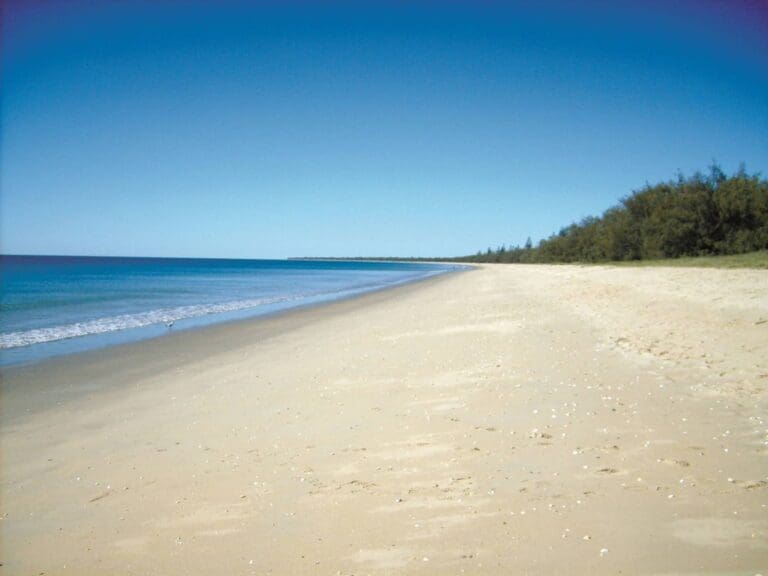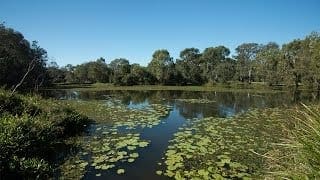Hike at a Glance
Max elevation: 0m
Min elevation: 0m
Total Ascent: 0m
Hike overview
Kingfisher Bay Resort to Lake McKenzie is on Fraser Island Great Sandy National Park and is a stunning destination.
At Kingfisher Bay Resort, walk to the right of the Village Store and go past the fuel bowsers, up the bitumen road and exit to the sand track on your left marked Beerillbee Trail / Lake McKenzie / Dundonga Circuit. The track is quite steep and sandy and this will take you out of the resort valley.
Continue to follow the signs to Lake McKenzie. At the ridge top, veer to the right and follow the track downhill to a junction with bollards and a track marker. Turn right following the fire trail to Dundonga Creek and then uphill to the crossing of Cornwells Break Road. Cross the road and follow the marked walking track to junction of Sleeper Hill Fire Trail. The climb up Sleeper Hill is long, but gentle. On the southern descent, cross Lake Wabby Road. Follow the fire trail cross the road and follow the walking track to Lake McKenzie Road and go through the National Parks boom gate and to Lake McKenzie picnic area.
Have lunch at Lake McKenzie and relax in the crystal clear blue water ringed by pure white sand and fringing Blackbutt forest. Lake McKenzie is a perched lake and is purely rain water fed. It is one of Fraser Island's premier attractions. Most of the walking track itself is compacted sand and the surface is not too difficult to traverse.
Tips
Bring a towel and swimmers to enjoy a swim at Lake McKenzie. There is limited mobile phone reception except at Kingfisher Bay Resort. Camping is available for hikers at Lake McKenzie (part of the Fraser Island Great Walk). Bookings can be made through the Queensland Department of National Parks, Sport and Racing.
Be Dingo Safe - don't approach or feed dingoes.
Gallery
Got some great shots from this hike? Upload your photos here to inspire others and show off the beauty of the trail!
Click to view form >>
Submitting your photos doesn’t mean you lose ownership. You can be credited for your contributions, and you can request removal at any time.
Content use
Please don’t copy GPX files or content from this site to AllTrails or other platforms. Each trail has been personally mapped, documented, and refined to support Australia’s bushwalking and hiking community. While some details come from land managers, every listing reflects significant personal effort. This is a free, community-driven initiative—your respect helps keep it that way.
Walk map and GPX file
It looks like I don’t have a GPX file for this trail yet. If you have one to share, please email it to me! I’ll verify it against official maps before adding it to help other hikers have a safer, easier experience. Thanks for contributing to a better hiking resource.
Getting there
Getting to the trailhead: Great Sandy National Park.
To get to Fraser Island, the Kingfisher Bay Ferry has three return services which depart River Heads (20 minutes south of Hervey Bay) daily and land at Kingfisher Bay Resort on the western side of Fraser Island. Bookings at www.fraserislandferry.com.au
At Kingfisher Bay walk to the right of the Village Store past the fuel bowsers, up the bitumen road exit to the sand track on your left marked Beerillbee Trail / Lake McKenzie / Dundonga Circuit.
Closest towns to this walk: Cooroy, Fraser Island, Gympie, Hervey Bay, Maryborough, Noosa Heads, Pomona, Rainbow Beach, Tin Can Bay
About the region
Long beaches, dramatic coloured-sand cliffs, natural sandblows, rocky headlands and pristine freshwater lakes and streams are some of K'gari's (Fraser Island's) spectacular natural features. Fraser Island, off Australia's eastern Queensland coast, is the world's largest sand island, stretching over 120km. Panoramic viewpoints include Indian Head, a rocky outcrop on the island's easternmost tip, and the Cathedrals, a cliff famous for sculpted ribbons of coloured sand. It's a camping and ecotourism destination, with beaches and swimming sites at Lake McKenzie, Lake Wabby and other freshwater pools.
Similar walks nearby
Looking for more walks in or near Great Sandy National Park? Try these trails with a similar difficulty grade.
Track grade
Grade 3 (Moderate) - Walks for Most Fitness Levels: Grade 3 on the AWTGS represents moderate walking tracks. These are ideal for walkers with some fitness who are comfortable with some hills and uneven terrain. While suitable for most ages, some bushwalking experience is recommended to ensure a safe and enjoyable experience. Tracks may have short, steep hill sections, a rough surface, and many steps. The total distance of a Grade 3 walk can be up to 20 kilometers.
Explore safe
Plan ahead and hike safely! Carry enough water, pack layers for changing conditions, and bring safety gear like a torch, PLB, and reliable communication device. Check official sources for trail updates, closures, and access requirements, and review local weather and bushfire advice. Most importantly, share your plans with someone before you go. Being prepared makes for a safer and more enjoyable hike! Stay Safe, Explore More, and Always #ExploreSafe.
Packing checklists
What you carry in your pack depends on factors like weather, terrain, and your adventure type. Not sure what to bring? My free planning, food, and packing checklists are a great starting point, covering day hikes, overnight trips, and multi-day adventures. Use them to customise your kit and always prioritise safety.
Let someone know
Before heading out, take a moment to fill out your trip intentions form. It’s a quick way to share your hike details with family or friends. If something goes wrong, they can notify emergency services, ensuring a faster response and peace of mind. Stay safe and enjoy your adventure
Suggest an edit
Spotted a change on this trail? Maybe there are new features, the route has shifted, or the trail is permanently closed. Whatever the update, I’d love your input. Your feedback helps fellow hikers stay informed and ensures that our trail info stays fresh and reliable.
Acknowledgement of Country
Trail Hiking Australia acknowledges the Traditional Owners of the lands on which we hike and pay respects to their Elders, past and present, and we acknowledge the First Nations people of other communities who may be here today.






